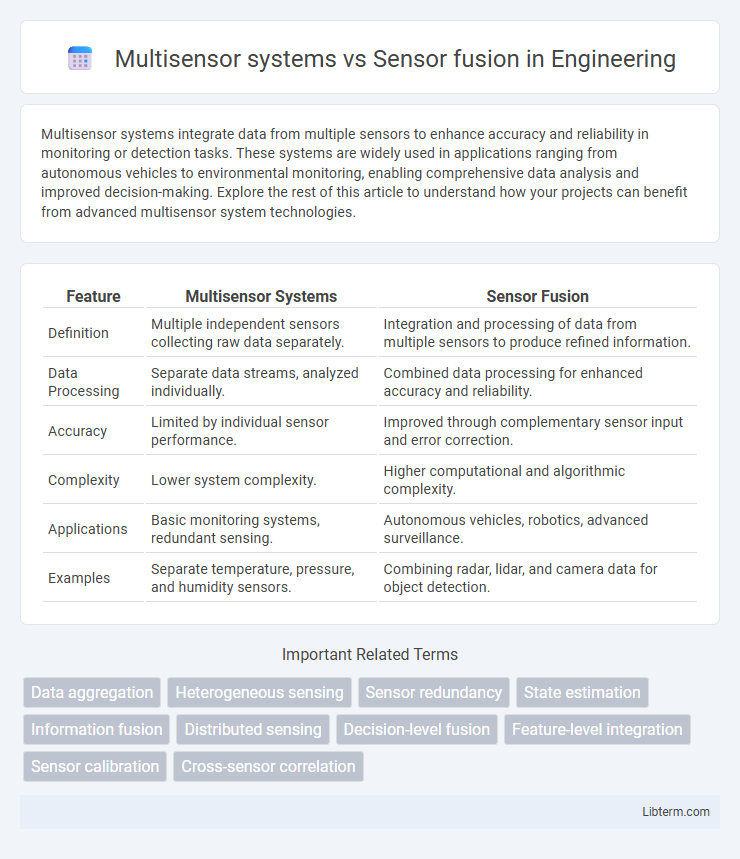Multisensor systems integrate data from multiple sensors to enhance accuracy and reliability in monitoring or detection tasks. These systems are widely used in applications ranging from autonomous vehicles to environmental monitoring, enabling comprehensive data analysis and improved decision-making. Explore the rest of this article to understand how your projects can benefit from advanced multisensor system technologies.
Table of Comparison
| Feature | Multisensor Systems | Sensor Fusion |
|---|---|---|
| Definition | Multiple independent sensors collecting raw data separately. | Integration and processing of data from multiple sensors to produce refined information. |
| Data Processing | Separate data streams, analyzed individually. | Combined data processing for enhanced accuracy and reliability. |
| Accuracy | Limited by individual sensor performance. | Improved through complementary sensor input and error correction. |
| Complexity | Lower system complexity. | Higher computational and algorithmic complexity. |
| Applications | Basic monitoring systems, redundant sensing. | Autonomous vehicles, robotics, advanced surveillance. |
| Examples | Separate temperature, pressure, and humidity sensors. | Combining radar, lidar, and camera data for object detection. |
Introduction to Multisensor Systems
Multisensor systems integrate multiple sensing devices to collect diverse data types for comprehensive environmental perception, enhancing accuracy and reliability. These systems utilize complementary and redundant sensors to monitor variables such as temperature, humidity, motion, and light, enabling robust decision-making in applications like robotics, automotive safety, and environmental monitoring. Sensor fusion, a key process within multisensor systems, combines data from different sensors to produce a unified, more precise output, reducing uncertainty and compensating for individual sensor limitations.
Understanding Sensor Fusion
Sensor fusion integrates data from multiple sensors to produce more accurate, reliable, and comprehensive information than individual sensors alone. In contrast, multisensor systems operate multiple sensors independently without combining their data at the processing stage. Understanding sensor fusion is key to leveraging techniques such as Kalman filtering, Bayesian inference, and machine learning, which enhance decision-making and situational awareness in applications like autonomous vehicles, robotics, and environmental monitoring.
Key Differences Between Multisensor Systems and Sensor Fusion
Multisensor systems involve multiple sensors operating independently or collaboratively to collect data from the environment, whereas sensor fusion integrates data from these multiple sensors to generate a unified, enhanced representation. The key difference lies in multisensor systems providing raw, separate sensor outputs, while sensor fusion algorithms process and combine these outputs to improve accuracy, reduce uncertainty, and enhance situational awareness. Sensor fusion techniques utilize methods such as Kalman filtering, Bayesian inference, or neural networks to achieve coherent data synthesis beyond the capabilities of individual multisensor components.
Core Components of Multisensor Systems
Core components of multisensor systems include multiple heterogeneous sensors, data acquisition modules, and processing units designed for individual sensor outputs. These systems integrate sensor arrays to capture diverse environmental data, emphasizing spatial and temporal sensor coordination. Sensor fusion, in contrast, specifically focuses on algorithms and methods to combine data from these sensors, enhancing reliability and accuracy by reducing uncertainties inherent in single-sensor measurements.
Sensor Fusion Architectures and Methods
Sensor fusion architectures integrate data from multiple sensors using centralized, decentralized, or distributed methods to improve accuracy and reliability. Common approaches include Kalman filters, Bayesian networks, and neural networks, which process heterogeneous sensor inputs to provide a unified, robust environmental model. These architectures optimize data correlation and uncertainty management, enabling enhanced decision-making in applications such as autonomous vehicles and robotics.
Advantages of Multisensor Systems
Multisensor systems integrate multiple independent sensors that provide diverse, redundant data streams, increasing reliability and fault tolerance compared to sensor fusion, which combines data at the processing level. These systems offer enhanced situational awareness by capturing a wider range of environmental parameters simultaneously, enabling more robust decision-making in complex environments. The modularity of multisensor systems also allows for easier scalability and sensor replacement without significant system redesign.
Benefits of Sensor Fusion
Sensor fusion enhances data accuracy and reliability by combining information from multiple sensors, reducing noise and mitigating individual sensor limitations. It enables comprehensive environmental perception and robust decision-making in applications like autonomous vehicles and robotics. Improved fault tolerance and real-time data processing capabilities make sensor fusion superior to using multisensor systems independently.
Common Applications of Multisensor Systems
Multisensor systems integrate data from multiple sensors to enhance accuracy and reliability in various environments, commonly used in autonomous vehicles for real-time navigation and obstacle detection. Industrial automation employs these systems for quality control and predictive maintenance by combining visual, thermal, and acoustic sensors. Robotics applications leverage multisensor systems to improve spatial awareness and manipulation precision by fusing inputs from lidar, cameras, and inertial measurement units (IMUs).
Sensor Fusion Use Cases Across Industries
Sensor fusion integrates data from multiple sensors to create a comprehensive understanding of the environment, enhancing accuracy and reliability in various applications. In automotive industries, sensor fusion is crucial for advanced driver-assistance systems (ADAS) and autonomous vehicles, combining inputs from LiDAR, radar, and cameras to improve object detection and navigation. Manufacturing leverages sensor fusion for predictive maintenance and quality control by aggregating signals from temperature, vibration, and pressure sensors to optimize equipment performance and reduce downtime.
Future Trends in Multisensor Systems and Sensor Fusion
Future trends in multisensor systems emphasize enhanced integration of heterogeneous sensors with AI-driven processing to improve accuracy and real-time decision-making in complex environments. Advances in sensor fusion techniques leverage deep learning algorithms and edge computing to enable adaptive, context-aware data interpretation for applications in autonomous vehicles, smart cities, and healthcare monitoring. The development of energy-efficient, miniaturized sensors combined with robust fusion frameworks promises scalability and improved performance in distributed sensor networks.
Multisensor systems Infographic

 libterm.com
libterm.com